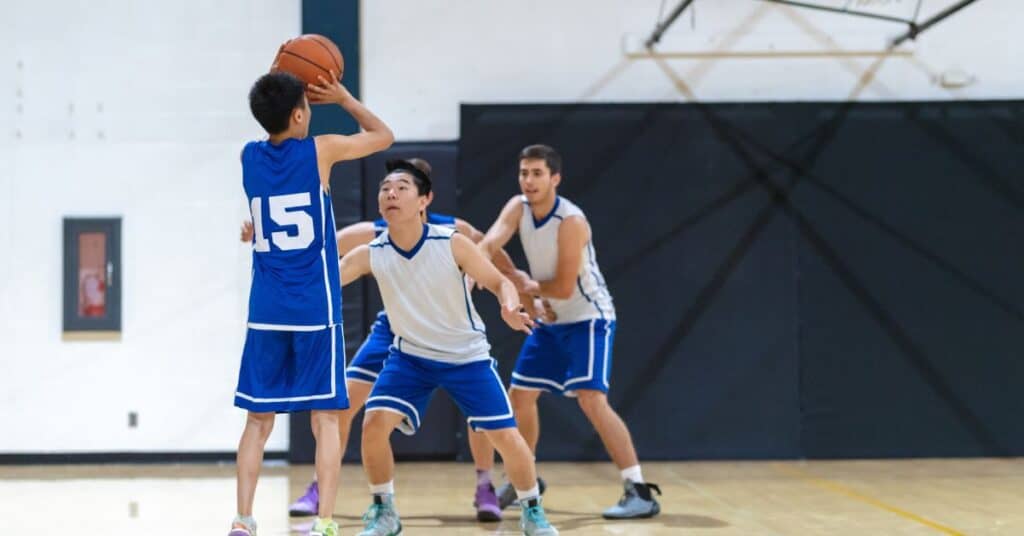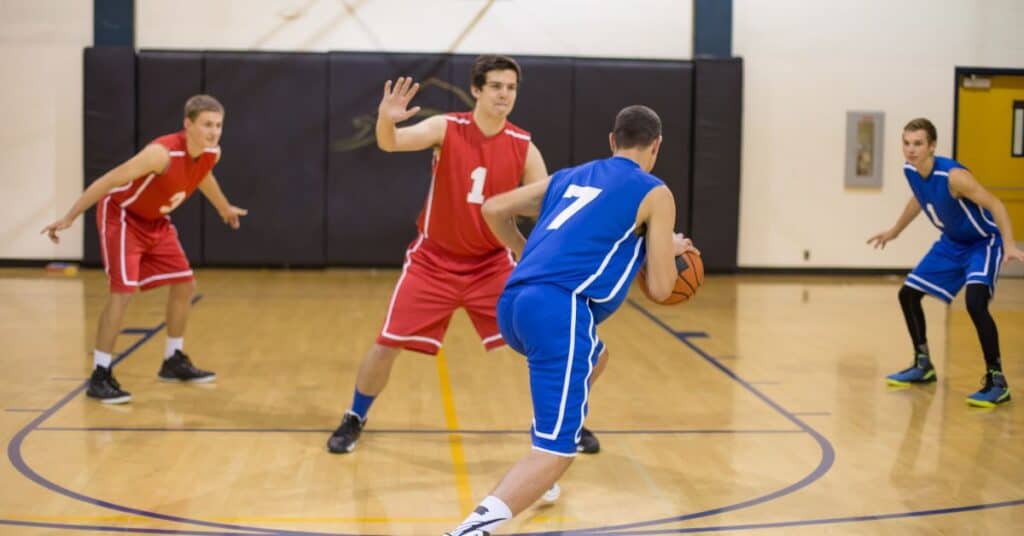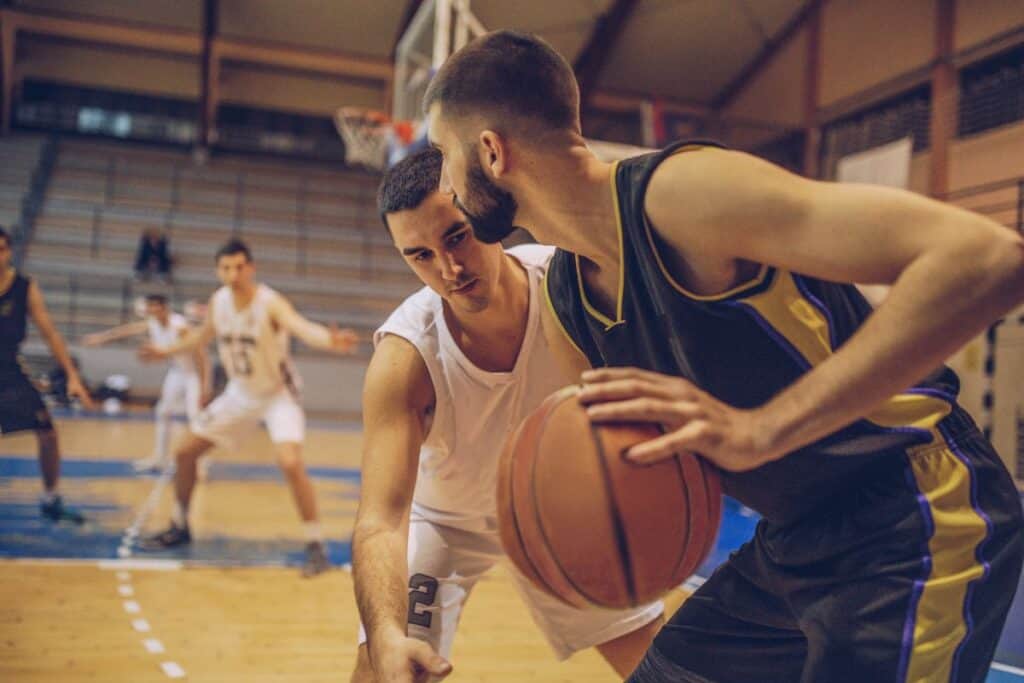Can you face guard in high school basketball?
High school basketball has some rules to make the game even and fair. Within basketball rules, is face guarding allowed in high school?

Face guarding is not allowed in high school basketball. Determining when a player is attempting to play the ball and when the defense is actively trying to cover the eyes of the offensive player is up to the referee. The resulting penalty is unsportsmanlike conduct.
We’ll explore some of the rules of basketball and explain what face guarding is, why it’s not allowed, and what refs think.
What is face guarding?
Being able to see is important in sports, especially while playing basketball. Face guarding is an effort by the defensive player to use their hands to block the opponent’s vision without a real effort to go after the ball.
Given that many sports, including basketball, don’t allow forced contact between the offensive player and defense, face guarding is generally attempted at a small distance with the defensive player actively moving their hands to cover the eyes of an opponent.
Can you face guard in high school basketball?
Let’s also dig into some of the unique rules around face-guarding in basketball:
Illegal even without the ball
Face Guarding is illegal in basketball regardless of whether or not the player being face guarded has the ball or not. Since players are often standing in close proximity without purposely obstructing (this is unlike football when the quarterback is often protected in the pocket), putting your hands in the way of someone who could receive the ball is illegal, in addition to doing so to the ball carrier.

What is the penalty for face guarding in high school?
If a referee believes you are face-guarding, the resulting penalty is an unsportsmanlike conduct technical foul on that player and a free throw opportunity. The thought that face guarding results in a technical foul is important too – because having a second technical foul in game results in that player being ejected.
The referee’s role in calling the foul
Some fouls, including physical contact, tend to be pretty obvious. Face guarding can be more subtle. Referees might notice, however, if a defensive player’s hands are rather high when the ball carrier’s hands are low while handling the ball. Also, consider that the defensive player is certainly allowed to have their arms up and to the side to prevent the offensive player from passing the ball around them. To us, an attempt at face guarding is more clear when the defensive player’s hands are high and at the center, without a real effort to play the ball.
We see a bit of a fine line because it does appear that face guarding could occur during a legal guarding position which generally involves both feet on the ground without arms extended.
Overall, we are looking at the referee’s judgment call, though the call isn’t made often.
How long has face guarding been illegal?
The state high school associations made face guarding illegal back over 100 years ago in 1913 and rewrote rules in 2014 to make an emphasis on face guarding.
Why is face guarding illegal?
While we can only speculate about why some rules are made, we feel that face guarding removes some of the competitive nature of the game and because having hands near another player’s eyes or face makes it more easily possible to poke someone’s eye in a sport known to avoid contact.
As a sport often viewed for entertainment, face guarding isn’t entertaining as putting your hands in the ball carriers or receiver’s face only requires them to move their body, so it isn’t really a good example of good defense either.
Are basketball rules geared to help the offense?
Yes and no. Part of the purpose of rules like face guarding within basketball and football is to allow the offensive team to at least see. Issues like face guarding are illegal both because they hinder the offense and because the act isn’t very safe – blocking a player’s view can easily result in getting hit in the face by either a hand or the ball, traveling at full speed.
Being able to get very good at blocking a player’s vision without contacting them is a skill that would slow down many offenses. Honestly, it doesn’t require the skill and strategy of preventing a pass from happening using your arms and body.
Teams are supposed to be able to score points in basketball, and face guarding prevents that while causing unnecessary risk.
What defenses can slow offenses down?
The use of arms and close guarding is possible. You won’t be called for a personal foul if you don’t initiate contact (we can’t really promise that, it depends on the ref and situation).
The idea behind the defense in basketball and many other sports is simply to prevent the offensive team from getting in a good position to take a shot – and maybe to get possession of the ball while doing so.
How you stop a team is a matter of studying them and coaches implementing a plan to do so.

Is face guarding illegal across all levels of play?
Face guarding is technically illegal across all levels of play, with the NBA offering fewer specifics about the rule. Regardless of the level, a defensive player isn’t allowed to put their hands up to the face of an offensive player unless they are attempting to get the ball, which is near the face of the offensive player.
Key Takeaways
- Face guarding is not legal in high school basketball.
- Players who are attempting to face guard will receive a technical foul
- Face guarding is the act of a defensive player blocking an offensive player’s eyes
- The act attempts to block the opponents’ vision.
- Hands and arms may be used to block the ball instead
